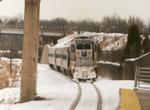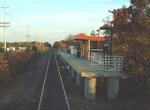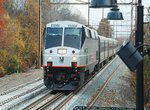New Jersey Transit Atlantic City Line
![]()
New Jersey Transit GP40PH-2B 4204 at Hammonton on the Atlantic City Line. Photo by Bob Vogel, August 2005.
Overview
NJT's Atlantic City line began life as an Amtrak service in May 1989 which beefed up former Pennsylvania-Reading Seashore Lines trackage between Philadelphia and Atlantic City. Before that, PRSL service, which had been cut back to the PATCO terminus in Lindenwold, ended in 1982 due to low ridership and poor track.
NJT had tried to fund the line's return with the promise of high-speed service. Several communities along the line fought the so-called "Gamblers Express" service with its many grade crossings that were seen as a safety threat. Amtrak managed to pick up the ball and get the line in operation. NJT commuter service began to operate between Lindenwold and Atlantic City in September 1989, with some service to 30th Street Station in Philadelphia beginning in May 1993. Amtrak service was less successful than hoped and was eliminated in 1995.
Train consists are diesel hauled, with various types of Comet push-pull in the consist. Although train length has varied, the standard train seems to be three coaches, with one generally not available to riders unless crowds dictate otherwise. Trains as short as two cars and as long as five cars have been seen at various times. All equipment is from NJT's pool and is deadheaded to and from the Kearny/Meadowlands complex as needed. At one time, moves were allegedly timed to allow consists to provide "Diesel Express" runs on NJT's Trenton line, but this appears unlikely since the Trenton trains generally require more than three cars.
Station By Station
NJT service begins on 30th Street Station's lower level, with the locomotive of the diesel consist usually on the Philadelphia end. Transfers can be made here to all lines of the SEPTA Regional Rail, the SEPTA Market-Frankford Elevated and the SEPTA Subway-Surface Streetcar Lines. Trains leave 30th Street and follow Amtrak trackage through Zoo Junction and onto the Northeast Corridor through North Philadelphia. Currently trains do not stop at North Philadelphia but this may change in the future. Trains move to the south side of the Corridor and exit it at Frankford Junction, where they begin their climbs up the massive Delair lift bridge across the Delaware River and enter New Jersey. Trains use the northern track only, with Conrail freights on the southern track on the structure.
A station is being built just off the Delair Bridge adjacent to Derousse Avenue, Cherry Hill, where the Atlantic City Line crosses the New Jersey Transit RiverLine, a diesel light rail line between Camden and Trenton.
Shortly after leaving the Jersey side of the bridge, the trains cross a few Conrail branches and a couple of busy highways (Westfield Avenue is crossed at grade) before ducking into a single-track cut which turns to the south. After passing over Route 38, Cherry Hill station is entered, with its passing siding. Some trains are scheduled to turn back at Cherry Hill at certain times, so there may a train laying over at this location occasionally. Cherry Hill was located in the middle of a large parking lot for Garden State Race Track. A large portion of this lot was recently redeveloped as a shopping center. The lot usually did not get much use, save for the annual New Jersey State Fair at the Track which used a large portion of the main parking lot and necessitated use of the auxiliary one.
Out of Cherry Hill, the trains vault over Route 70 and return to grade, with a grade crossing just inside Cooper River Park, then duck back into a cut through the town of Westmont. The line turns to the east slightly and joins the PATCO right-of-way as it drops into its own cut to traverse Haddonfield. The railroad track is in a deeper cut, with the PATCO station barely visible from NJT trains. Trains continue parallel to PATCO on to Lindenwold, varying from the cut in Haddonfield to surface to embankment east of Woodcrest, back to grade just before entering Lindenwold.
At Lindenwold, the NJT station is next to the station of the PATCO High-Speed Line, although PATCO's is on embankment. The former PRSL platform, built as part of the PATCO station, can be seen. Most of this low-level platform has been built over for the current high-level one. PATCO's yard and shop are to the north of the trains (to the left of outbounds, as we are travelling). Just west of the station, a siding is located where PRSL RDC units layed up between runs. The siding still connects with PATCO's yard trackage and is PATCO's connection to the outside rail world.
Leaving Lindenwold, the line becomes laced with grade crossings as it runs in a median area between two parallel roads for a short distance. This area is sufficiently busy with traffic that train speeds are kept lower than they could be. Once out of this area, trains open up for a short distance, then enters an embankment before reaching Atco station. Atco is just across busy Route 73 and close to a large movie multiplex.
Past Atco, the line goes back to grade, passing Winslow Junction, the former split of PRSL services to Atlantic City and southern shore points such as Ocean City and Wildwood/Cape May as well as a crossing of a former Central Railroad of New Jersey line to Jersey City. Winslow also features a long passing siding where trains are sometimes scheduled to meet. Shortly, Hammonton station is reached. Hammonton has several grade crossings and the line runs through the heart of the town, necessitating another slow run. Hammonton's PRSL station building still stands and can be seen just before the new station is reached.
The line straightens out and appears to leave civilization for a while as it zips through the Jersey Pinelands. Egg Harbor station seems to appear out of the pines, and once the stop is cleared, the trains seemingly re-enter the woods. Another passing siding at Pomo, about five miles past Egg Harbor, is another place to expect a meet, depending on schedules. The siding is close to Pomona, the location of Atlantic City International Airport and a federal aviation test center. At various times, the possibility of an intermodal station here has been discussed but nothing has materialized so far.
Trains leave the pines and development becomes plentiful again, and the track rises onto an embankment just before Absecon station comes into view. The station is on this embankment and requires an elevator for access for those who cannot climb the stairs (other stations can be accessed by zig-zag ramps as well as short stairways). Absecon is the last station on the mainland, so to speak - it is a little-known fact that Atlantic City, as most of its Jersey coast resort towns, is on a barrier island. The track continues on its embankment through the marshland, with the towers of Atlantic City coming into view. The single track becomes two about two miles from Absecon and remains that way into the last stop. The busy Atlantic City Expressway, with its median parking areas for casino employees, is just to the south of the trains.
Trains cross a swing bridge over what locals call the "Thoroughfare" and immediately enter the Atlantic City station interlocking. The Atlantic City terminal is a 5-track, 3-platform affair next to the city's new convention center. The famous Boardwalk, as well as the old Convention Center (famous for Miss America), are over a half-mile to the east and require a healthy walk or a jitney ride from the train station.
Train operation may get a little more complicated as a highway connection known locally as "the tunnel", linking the Atlantic City Expressway with the city's Marina District to the north, will likely cut across the terminal lead trackage at grade. While exact details are not yet worked out, this could severely hinder rail operations.
NJT trains operate on varying schedules depending on the time of year. In summer periods, a couple of extra trains are operated, especially on weekends. Basic service is 12-14 trains per day each way on no set schedule pattern, as the single track and availability of 30th Street platforms and Delair bridge windows seem to dictate when trains can run. Service runs from early morning to late at night. Train tickets are honored between Lindenwold and Atlantic City on NJT's Route 554 bus, which operates hourly on the White Horse Pike (Route 30).
At this writing, the maximum fare is $6 one way. Tickets are purchased from vending machines which are available at all stations. Clerks man ticket windows at Atlantic City at certain times. Although there are conductors on board trains, their responsibilities are to check, not punch, tickets - ticket validators are also placed at each station to be used for just that purpose.
Stations along the line are high-level, standard NJT-issue affairs with bus stop-type shelters in addition to the machines. All stations are accessible.
Photo Gallery
| Five Random Images | ||||
 Image 20570 (41k, 520x359) Photo by: Jason R. DeCesare Location: Lindenwold |  Image 20573 (103k, 805x578) Photo by: Bob Vogel Location: Atco |  Image 20575 (135k, 790x620) Photo by: Bob Vogel Location: Atlantic City |  Image 141224 (412k, 1044x703) Photo by: Lee Winson Location: Pennsauken Transit Center |  Image 141226 (254k, 1044x703) Photo by: Lee Winson Location: Pennsauken Transit Center |
Photos By Location
Photo locations: 30th Street Station, Zoo Interlocking Area, Delair Bridge, Pennsauken Transit Center, Westfield Avenue Grade Crossing, Pennsauken, Cherry Hill, Lindenwold, Washington Ave. Grade Crossing - Berlin, NJ, Atco, Hammonton, Egg Harbor City, Absecon, Atlantic City
Page Credits
By Bob Wright.